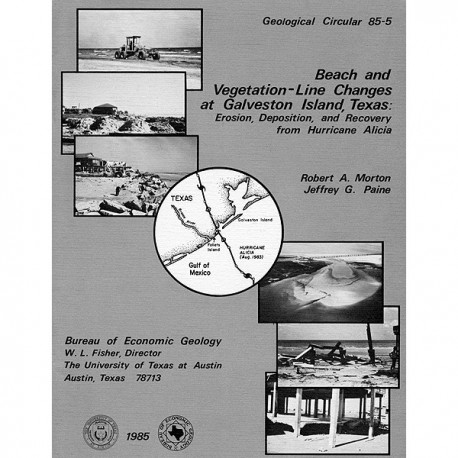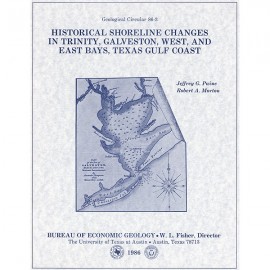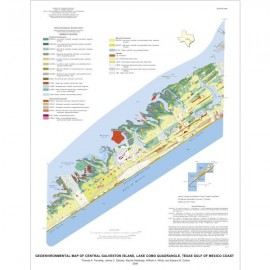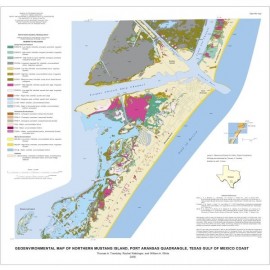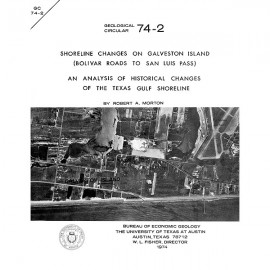Geological Circulars
-
Books & Reports
- Reports of Investigations
- Guidebooks
- Udden Series
- Geological Circulars
- Down To Earth
- Atlases of Major Oil and Gas Reservoirs
- Texas Memorial Museum Publications
- Environmental Geologic Atlas of the Texas Coastal Zone
- Mineral Resource Circulars
- Other Reports
- Seminars and Workshops
- Handbooks
- Submerged Lands of Texas
- Symposia
- Annual Reports
- Open File Reports
-
Maps & Cross Sections
- Thematic Maps
- Miscellaneous Maps, Charts & Sections
- Geologic Atlas of Texas
- STATEMAP Project Maps
- Geologic Quadrangle Maps
- Cross Sections
- Highway Geology Map
- Energy and Mineral Resource Maps
- Shoreline Change and Other Posters
- Wilcox Group, East Texas, Geological / Hydrological Folios
- Bouguer Gravity Atlas of Texas
- River Basin Regional Studies
- Featured Maps
- Posters
- Teachers & the Public
-
Geological Society Publications
- Gulf Coast Association of Geological Societies
- Alabama Geological Society
- Austin Geological Society
- Corpus Christi Geological Society
- Houston Geological Society
- Lafayette Geological Society
- Mississippi Geological Society
- New Orleans Geological Society
- South Texas Geological Society
- GCS SEPM Publications
- Historic BEG & UT Series
Beach and Vegetation-Line Changes at Galveston Island, Texas: Erosion, Deposition, and Recovery from Hurricane Alicia
GC8505
For a downloadable, digital version: GC8505D.
GC8505. Beach and Vegetation-Line Changes at Galveston Island, Texas: Erosion, Deposition, and Recovery from Hurricane Alicia, by R. A. Morton and J. G. Paine. 39 p., 24 figs., 5 tables, 3 appendices, 1985. ISSN: 0082-3309. Print.
To purchase this publication as a PDF download, please order GC8505D.
ABSTRACT
On August 18, 1983, Hurricane Alicia crossed the upper Texas Gulf Coast and caused extensive property damage, especially along West Beach of Galveston Island. Aerial photographs taken before and after Alicia and field measurements made during the first 2 yr after the storm provide a basis for determining nearshore changes associated with a major hurricane and for predicting potential beach recovery. Alicia caused substantial landward retreat of both the shoreline and the vegetation line. Retreat of the vegetation line ranged from 20 to 145 ft and averaged about 80 ft. Erosion was generally greatest near the Sea Isle and Bay Harbor subdivisions, where storm processes were most intense; beach erosion generally decreased away from San Luis Pass, which is near the site of storm landfall. Surface elevations were lowered as much as 4.5 ft, and many Gulf-front houses were undermined and exposed on the beach after the storm.
Alicia eroded more than 2 million yd3 of sand from West Beach. About one-tenth of that sand was deposited on the adjacent barrier flat as a washover terrace. Washover penetration was greatest to the east of the storm's eye and along developed shoreline segments. The remaining eroded beach sand was deposited offshore as shoreface bars or as storm deposits on the inner shelf. The shoreface deposits promoted rapid forebeach accretion during the first post-storm year; at the same time the backbeach elevation remained about 2.5 to 3 ft lower than before the storm, and the natural post-Alicia vegetation line remained essentially unchanged. Recovery of the vegetation line 2 yr after the storm was insignificant, mainly because the depth of beach erosion exceeded root depth, thus eliminating plants from some areas that were densely vegetated before the storm.
Natural seaward advancement of the forebeach after Alicia was accompanied by diverse and widespread human alteration of the backbeach in developed communities. These modifications principally involved spreading sand fill, repositioning storm rubble, constructing bulkheads, building artificial dunes, planting dune grasses, watering and fertilizing the grass, and erecting sand fences. These human modifications tended to obscure the natural vegetation line and to narrow the beach.
Hurricane Alicia (1983) caused more beach erosion than did Hurricane Allen (1980) but less than Hurricane Carla (1961). Although the vegetation line returned to its pre-Carla position in some West Beach areas, it did not fully recover along most segments because of long-term beach erosion. As in the past, future recovery of the vegetation line will depend on severity of storm damage, storm recurrence and strength, shoreline stability, and coastal climate. This study shows that beach erosion caused by Alicia was substantial, that the Gulf beach of Galveston Island is frequently influenced by storms, and that much of West Beach is eroding. Therefore, natural recovery of the vegetation line to its pre-storm position is unlikely along eroding segments, and substantial seaward advancement even along relatively stable shoreline segments will take several years. Some human activities in developed areas have artificially raised the backbeach and advanced the vegetation line nearly to its pre-storm position. Such manipulation will be difficult to detect as dunes grow and vegetation density increases.
Historical records clearly show that Galveston beachfront property will receive minor storm damage every few years and extreme storm damage about every 20 yr. Frequent storms and long-term beach erosion are important considerations when planning for future use of the beach and barrier island.
Keywords: barrier islands, beach profiles, coastal geology, Galveston Island, Hurricane Alicia, shoreline changes, storm processes, Texas Gulf Coast, Texas, vegetation
Citation
Morton, R. A., and Paine, J. G., 1986, Beach and Vegetation-Line Changes at Galveston Island, Texas: Erosion, Deposition, and Recovery from Hurricane Alicia: The University of Texas at Austin, Bureau of Economic Geology, Geological Circular 85-5, 39 p.
